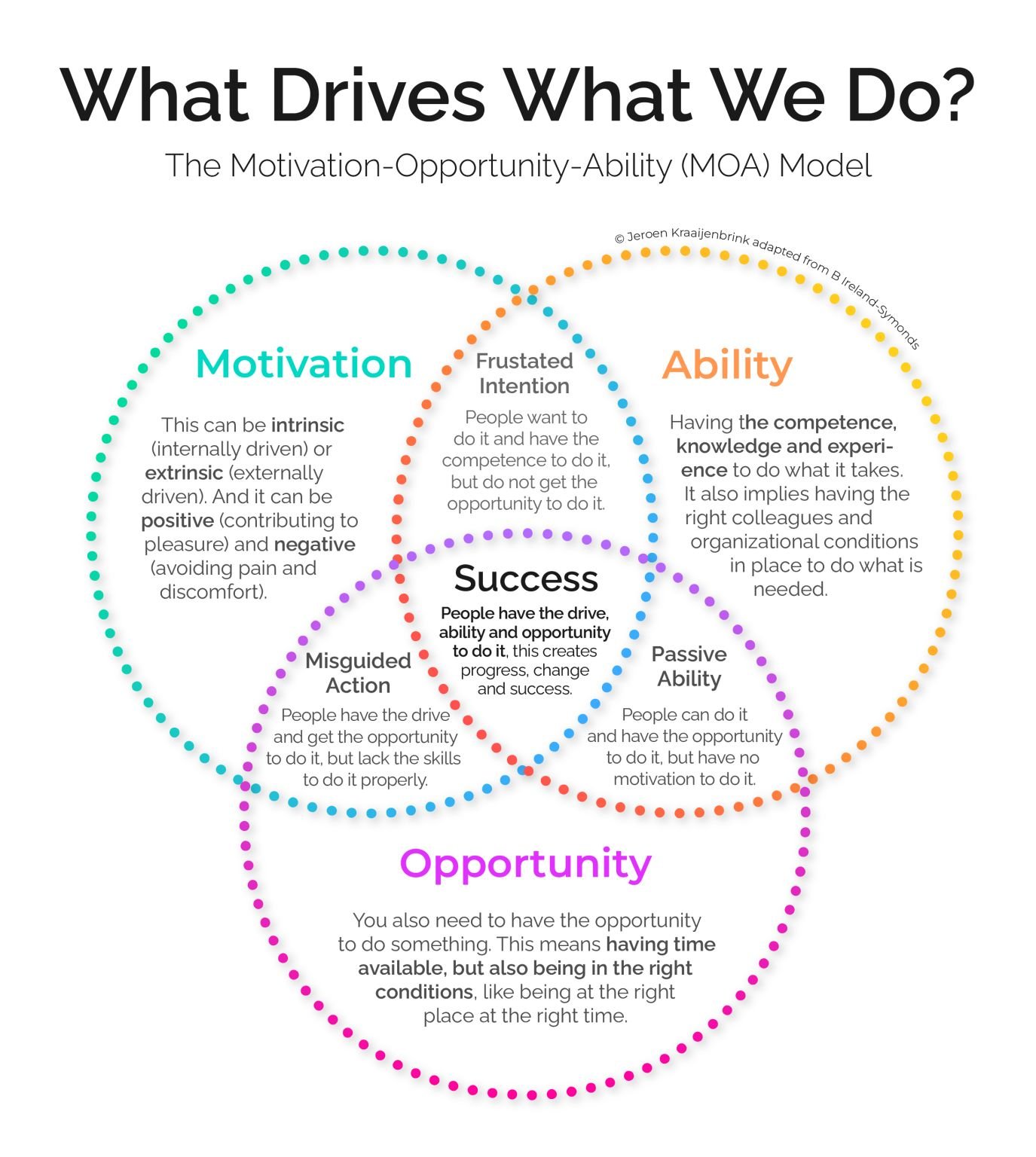Định hướng của bạn là làm gì?
Quote from bsdinsight on 16 November 2023, 11:14Understanding why we do things is fascinating. And it is important too, because it allows us to foster change and achieve what we want. The MOA model provides such understanding.
There are many models explaining human behavior. A simple and useful one is the MOA model—which stands for Motivation, Opportunity and Ability. The model explains in general what drives human action and can be applied to any imaginable type of action.
This is what it means:
Motivation
The first condition for action to happen is the motivation to do it in the first place. This can be intrinsic (internally driven) or extrinsic (externally driven). And it can be positive (contributing to pleasure) and negative (avoiding pain and discomfort).Opportunity
Motivation is not enough to explain behavior. You also need to have the opportunity to do something. This means having time available, but also being in the right conditions, like being at the right place at the right time.Ability
The third and final element is ability. This means having the competence, knowledge and experience to do what it takes. It also implies having the right colleagues and organizational conditions in place to do what is needed.There’s many applications and versions of this model, including the means, motive and opportunity “categorical trinity” used in law. The bottomline, though, is always the same: all three are needed:
Miss motivation and you get passive ability: people can do it and have the opportunity to do it, but have no motivation to do it—so nothing good happens.
Miss opportunity and you get frustrated intention: people want to do it and have the competence to do it, but do not get the opportunity to do it—so nothing good happens.
Miss ability and you get misguided action: people have the drive to do it and get the opportunity to do it, but lack the skills to do it properly—so nothing good happens.
There’s a couple of situations and ways in which the model can be used in organizations:
• In change efforts to identify whether all three elements are sufficiently in place
• In strategy execution to make sure all that is needed to implement a strategy can and will be actually done
• Retrospectively when there is stagnation to identify bottlenecks and barriers for progresIn line with this last point, reflect on a recent initiative. Were Motivation, Opportunity and Ability sufficiently in place?
Want more of this? Subscribe to my Soulful Strategy LinkedIn Newsletter and receive it once a month directly in your inbox.
Understanding why we do things is fascinating. And it is important too, because it allows us to foster change and achieve what we want. The MOA model provides such understanding.
There are many models explaining human behavior. A simple and useful one is the MOA model—which stands for Motivation, Opportunity and Ability. The model explains in general what drives human action and can be applied to any imaginable type of action.

This is what it means:
Motivation
The first condition for action to happen is the motivation to do it in the first place. This can be intrinsic (internally driven) or extrinsic (externally driven). And it can be positive (contributing to pleasure) and negative (avoiding pain and discomfort).
Opportunity
Motivation is not enough to explain behavior. You also need to have the opportunity to do something. This means having time available, but also being in the right conditions, like being at the right place at the right time.
Ability
The third and final element is ability. This means having the competence, knowledge and experience to do what it takes. It also implies having the right colleagues and organizational conditions in place to do what is needed.
There’s many applications and versions of this model, including the means, motive and opportunity “categorical trinity” used in law. The bottomline, though, is always the same: all three are needed:
Miss motivation and you get passive ability: people can do it and have the opportunity to do it, but have no motivation to do it—so nothing good happens.
Miss opportunity and you get frustrated intention: people want to do it and have the competence to do it, but do not get the opportunity to do it—so nothing good happens.
Miss ability and you get misguided action: people have the drive to do it and get the opportunity to do it, but lack the skills to do it properly—so nothing good happens.
There’s a couple of situations and ways in which the model can be used in organizations:
• In change efforts to identify whether all three elements are sufficiently in place
• In strategy execution to make sure all that is needed to implement a strategy can and will be actually done
• Retrospectively when there is stagnation to identify bottlenecks and barriers for progres
In line with this last point, reflect on a recent initiative. Were Motivation, Opportunity and Ability sufficiently in place?
Want more of this? Subscribe to my Soulful Strategy LinkedIn Newsletter and receive it once a month directly in your inbox.

